Chops: Advanced
Theory: Advanced
Lesson Overview:
• Understand how to create and
use 12-tone rows.
• Develop musical motifs by
altering tone rows.
• Combine string skipping and
octave displacement to create
angular lines.
It isn’t uncommon for me to write tunes that are often based on all 12 notes. The notes are organized in the order of how my ear likes to hear them. Also, I don’t repeat a note until all the other notes are played. I write one at a time, carefully listening to the interval between each note and the next, the same as anyone would when composing a melody. I like writing with 12-tone rows because it gives me my own unique voice.
Arnold Schoenberg (1874-1951) is the foremost 12-tone composer—he was writing 12-tone tunes in the 1920s! Frank Zappa composed some songs using this technique, and Ron Jarzombek is a modern metal composer who routinely uses tone rows in his compositions.
Last Chance to Reason—the band I play in—has always been a little outside of the ordinary when it comes to tonality. We’ve always used dissonant sounds we may have picked up from extreme genres such as prog and metal. Our drummer, Evan Sammons, and I decided to write some 12-tone music in 2006 for our first album, Level 1. Most of that record contained various tone rows, their inversions, retrogrades, and rhythmic variations. Less that 10 percent of the record consists of tonal melodic music. Our next record, Level 2, used tone rows extensively, but transitioned from them into more harmonic and melodic sections.
To compose a row, I often write down all the notes of a chromatic scale, from A through G#. As I compose the row on my guitar by ear, I cross out the notes in the chromatic scale and write the note names of my new melody below the chromatic scale. The intervals or distance between each note give my tone rows a distinct sound. Like other melodies, not every tone row will sound good. Mine are carefully composed one note at a time and reworked until the whole melody rocks.
Shown in Fig. 1, the tone row in “Upload Complete” uses a combination of my favorite intervals, or movements, to make up a heavy melody. This line is used in many variations throughout the tune. In order to critically analyze how these lines are composed, you are going to need to be pretty solid on your intervals.
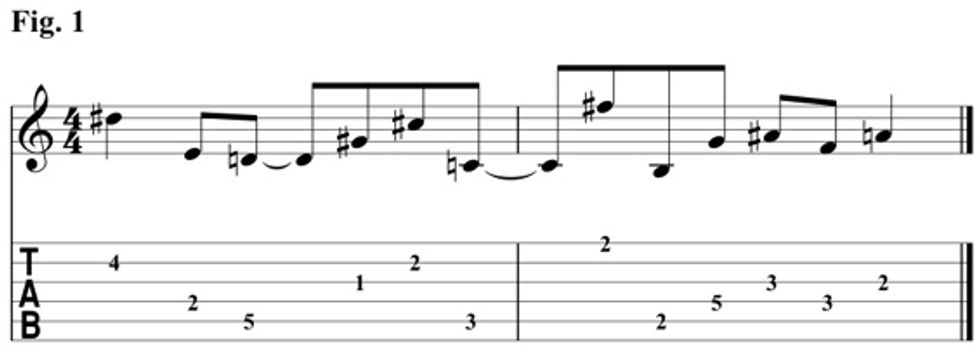
There are a few intervals I want to highlight here. The first one is the distance between the first two notes—a major seventh. This is a very modern and powerful sounding interval. The last two notes of the first measure outline a minor ninth, which is probably my favorite melodic movement. It seems to be very popular with the more rhythmic metal and djent bands. Going into the second measure we have an augmented eleventh, which is the largest jump so far. This is what is referred to as a compound interval. A compound interval can be considered two intervals stacked on top of each other. In this case, we have an octave plus a tritone between C and F# an octave higher.
The intro phrase in “Upload Complete” is shown in Fig. 2. Our drummer Evan and I combined five or six motifs to make a grooving rhythmic phrase. A motif can be thought of as the smallest form of a musical idea, and a group of motifs make up a phrase. Each of these motifs used three or four notes from the tone row.
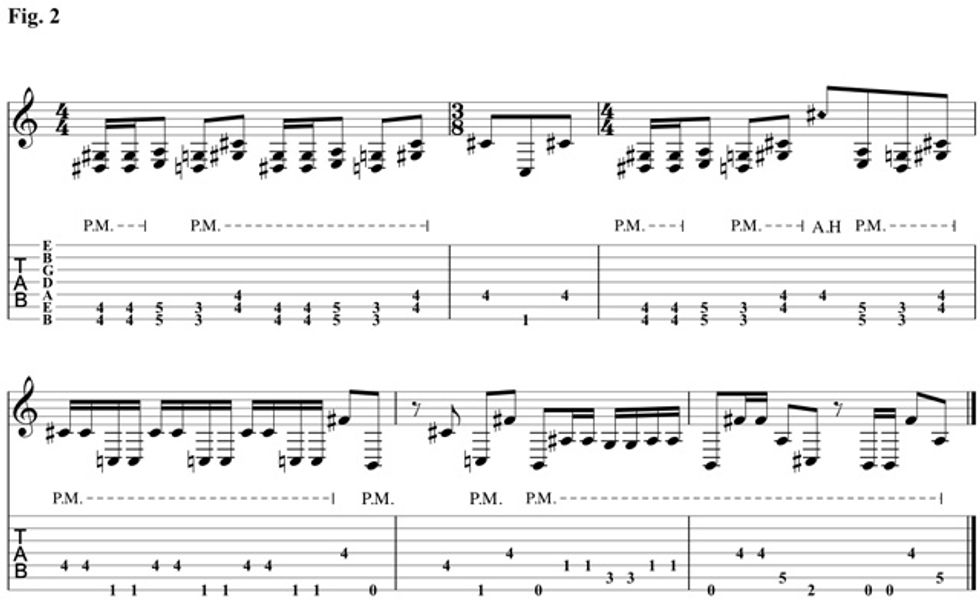
This is a more musical way of developing a tone row than anything on Level 1. I like to call it a motifically developed tone row because three- or four-note motifs are repeated and expanded upon until the notes are used up. It then resolves with the tone row in its entirety.
If we start to dissect the phrase, it starts with the first four notes of the tone row repeated twice. Then, we go to the next two notes of the row, and back to the first group of four notes again. The double-picked 16th-notes go between the fifth and sixth notes of the tone row. At this point we add notes seven and eight to the phrase. After we make a four-note motif with notes five, six, seven, and eight, we repeat them and tack on the ninth and tenth notes. The last four-note motif of the riff includes the twelfth note. I skipped the eleventh because my ear didn’t want to hear it.
Let’s take a look at how we can vary a tone row to make it more interesting. The row shown in Fig. 3 is from our song “In Portal.” This is the original form and each measure of the phrase takes a different approach, but keeps the order of the notes intact.
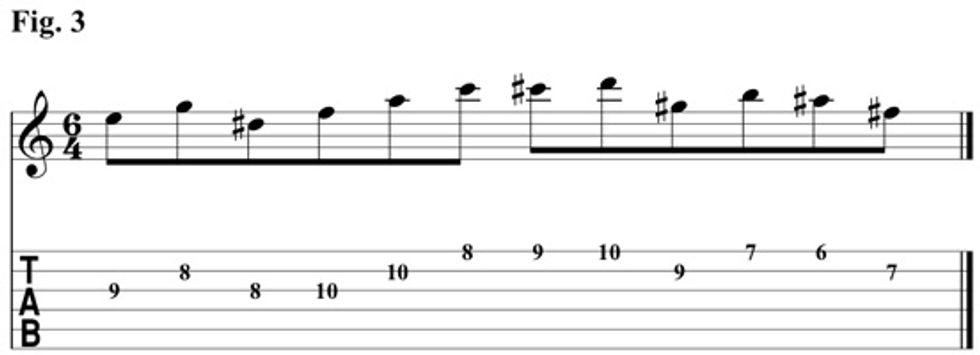
Fig. 4 is the same row transposed down an octave. It’s a very simple idea, but the different fingering options give us some new patterns to work through. The third measure, shown in Fig. 5, is my favorite and the most challenging. We combine some string skipping with octave displacement to create a very angular sound. Applying octave displacement—where you just move certain notes in the phrase either up or down an octave—adds an instant sense of urgency and tension to your lines. I move to 7-string guitar for Fig. 6. In this measure I play the row down an octave and harmonize it in fourths.
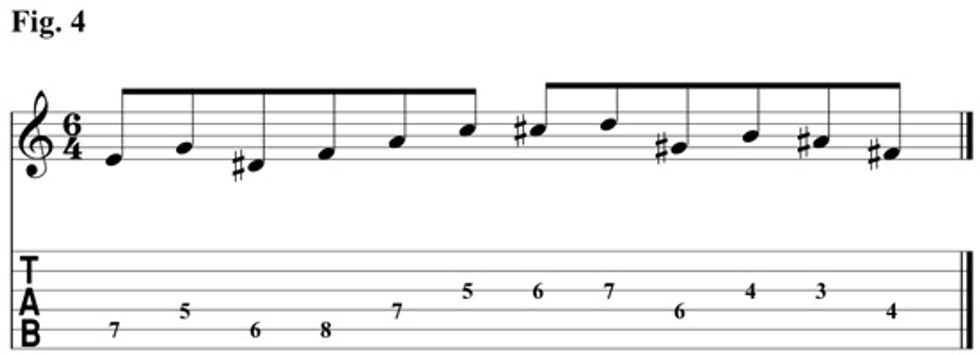
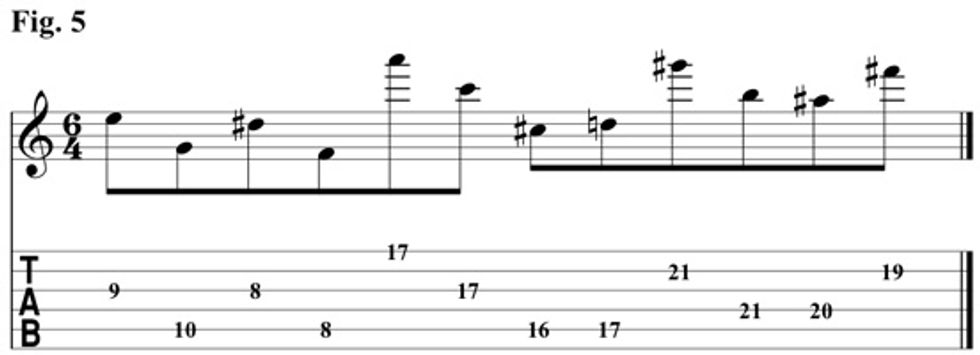
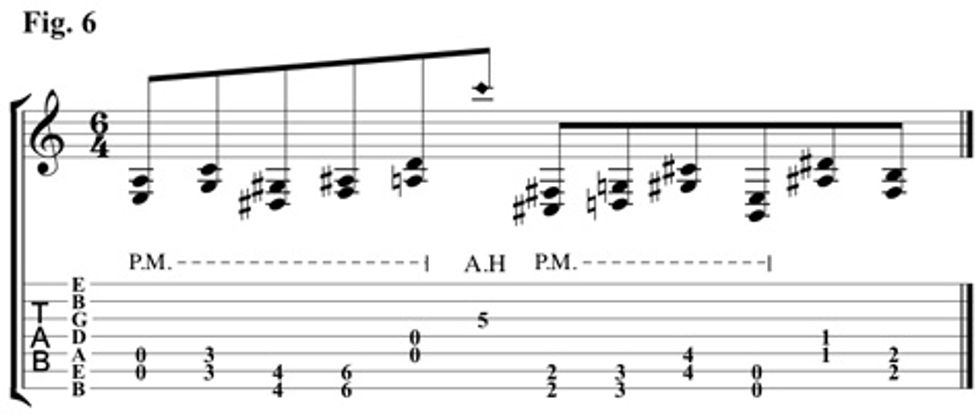
Getting around writer’s block is tough for any musician. Learning about 12-tone rows and how they function is a great way to compose a song because your melody instantly sounds original—and it likely is. In heavy music, there are a few techniques, sounds, and styles that most guitar players gravitate toward. If you use 12-tone rows to compose, your riffs will have a different sound and vibe from other songs you’ve written.
 AJ Harvey has been
a member of the video game-inspired metal
band Last Chance to Reason for the last eight years. Their latest
album, Level 2, is full of mathcore riffs, facemelting
chops, and even contains a Metroidstyle
video game. For more information, visit facebook.com/lastchancetoreason.
AJ Harvey has been
a member of the video game-inspired metal
band Last Chance to Reason for the last eight years. Their latest
album, Level 2, is full of mathcore riffs, facemelting
chops, and even contains a Metroidstyle
video game. For more information, visit facebook.com/lastchancetoreason.








![Rig Rundown: John 5 [2026]](https://www.premierguitar.com/media-library/youtube.jpg?id=62681883&width=1245&height=700&quality=70&coordinates=0%2C45%2C0%2C45)







